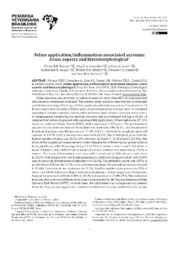Feline application/inflammation-associated sarcoma: gross aspects and histomorphological.
Feline application/inflammation-associated sarcoma: gross aspects and histomorphological.
Author(s): NOVAES, V. R. F.; CONSALTER, A.; LEITE, J. S.; SOUZA, G. N. de; OLIVEIRA, T. E. S.; CUNHA, S. C. S.; FERREIRA, A. M. R.
Summary: Feline injection-site sarcomas in felines account for more than 40% of cutaneous and subcutaneous neoplasms in felines. The present study aimed to describe the macroscopic and histomorphological findings of feline application/injection sarcomas. Samples from 31 feline tumors with a history of feline application/inflammation sarcoma were re-evaluated regarding histological subtype, mitotic index and score, depth of tissue invasion, and presence of inflammation considering the location, intensity and predominant cell types. Of the 31 samples from felines diagnosed with sarcoma at the application/inflammation site, 87.15% were cats with no defined breed (NDB), with a mean age of 8.5 years. The predominant anatomical sites were the back and flank/abdomen, both with 29% (9/31), and the prevalent histological subtype was fibrosarcoma at 77.4% (24/31), followed by anaplastic giant cell sarcoma at 12.9% (4/31) and myxosarcoma 9.6% (3/31). The histological grade with the highest number of cases was 111 (51.6%), followed by Grade II (35.4%) and I (12.9%). The mean of the longest axis measurements varied between the different tumor grades without being significant, with the average being 2.5+2.79cm in Grade I tumors and 3.2+2.28cm in Grade Il tumors. and 4.68+2.07cm in Grade ll tumors. Necrosis was observed in 74.2% of tumors. The tissue inflammation score was mild to moderate in 58% of cases and severe in 32.2%, with lymphocytic and lymphoplasmacytic infiltrates being prevalent, with 25.8% each, followed by lymphoplasmohistiocytic with 22.6%. The infiltration depth was 38.7% in muscle tissue, followed by 32.2% in the subcutaneous tissue. Pleomorphism was accentuated in 51.6%. Desmoplasia was moderate in 45.1%. Satellite nodules were present in 29% of cases, and 19.4% had macrophages with intracytoplasmic content suggestive of adjuvants. Surgical margins were infiltrated (M1) in 48.4% and narrowed in 25.8% (M2). The anatomical locations observed were different from those recommended by the Vaccine-Associated Feline Sarcoma Task Force (VAFST); in most cases, the adjuvanted macrophage was not present. From this data, we can suggest that sarcomas in felines are not only correlated to the vaccine application, corroborating the hypothesis that any material, whether liquid or solid, and any chronic inflammatory process in the subcutaneous tissue of cats can induce the entity if they are predisposed to do so. The detailed histomorphological data evaluated in this study were key points and provided important information about tumor behavior, being a tool for clinical-oncological decision-making.
Publication year: 2024
Types of publication: Journal article
Unit: Embrapa Dairy Cattle
Keywords: Fibrossarcoma, Gato, Histomorfológico, Histopatologia, Inflamação, Sarcoma
Observation
Some of Embrapa's publications are published as ePub files. To read them, use or download one of the following free software options to your computer or mobile device. Android: Google Play Books; IOS: iBooks; Windows and Linux: Calibre.
Access other publications
Access the Agricultural Research Database (BDPA) to consult Embrapa's full library collection and records.
Visit Embrapa Bookstore to purchase books and other publications sold by Embrapa.

